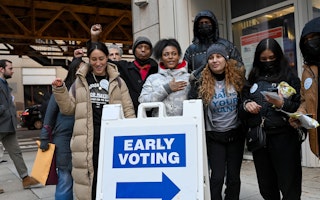Bias Warps the Way African American Girls Are Treated at School
By Janel George

Our education system is a reflection of our society, along with all of its attendant biases, belief systems, and norms. African American girls in school encounter race and gender biases, which lead them to be unfairly labeled as aggressive, unfeminine, loud, disruptive, and noncompliant.
These are all code for stereotypes of African American girls as not fitting within prevalent white norms of feminine behavior and requiring social correction. These biases play out not only in discipline disparities impacting African American girls, but also in violent and inappropriate confrontations between police and young black women.
These violent interactions range from the bikini-clad teenager who was wrestled to the ground by a white male police officer in McKinney, Texas, to the African American female teenager in the viral video from Spring Valley High in Columbia, South Carolina, who was choked, wrestled, and thrown to the floor by a white male school police officer. Viewed in the context of belief systems that devalue African-American girls and project marginalizing and negative stereotypes on them, the Spring Valley High video reflects a disciplinary response that is not surprising—or rare.
The consequences of such disciplinary responses are just as troubling. Research shows that students subjected to suspensions, expulsions, or school-based arrests often suffer from feelings of stigmatization and disengagement from the learning environment, and are more likely to be retained, held back a grade, or drop out of school.
In our recent report on African American girls and education, Unlocking Opportunity for African American Girls: A Call to Action for Educational Equity, the NAACP Legal Defense and Educational Fund, Inc., and the National Women’s Law Center highlight how race and gender biases held by educators and school administrators impact the educational experiences of African American girls. The report points to data showing that 12 percent of all African American female students received an out-of-school suspension, which is six times the rate of white girls, and more than most boys.
This is despite data showing that African American children do not misbehave more frequently than their white peers. Therefore, the disparity is not in the behavior itself, but in the response to the behavior. And that response is largely shaped by bias.
Data show for “objective” disciplinary categories, like smoking, the discipline rates between white and black students are comparable. It is within discretionary discipline categories, in which there is broad room for bias to come into play, where racial disparities are notably present—categories such as “school disruption,” for which the teenager in the video was charged, or dress code violations, or the catch-all “willful defiance.” Discretion allows room for implicit bias—unconscious beliefs that we all hold about others based on characteristics like race or age.
This bias is also reflected in the reactions to the assault of the teenager in the Spring Valley High video, some of which supported the officer’s conduct, including reactions from black educators. Implicit bias deems her “deserving” of the violent physical assault following the alleged cell phone violation, even as most agree that it is difficult to imagine condoning such a response against a white female student.
Unless we acknowledge race and gender bias, both implicit and explicit, and the ways in which they color perceptions of and disciplinary responses to African American students, we are doomed to see yet another viral video of an overly punitive disciplinary response. Instead of pushing students out of school through zero-tolerance policies for minor offenses, schools can implement inclusive alternatives like peer mediation, restorative practices, and youth courts that keep kids in school, help them to acknowledge any wrongdoing, and provide a forum for healing.
Training school administrators on implicit bias and cultural competency can help to disrupt perceptions that impact discipline decisions and fuel racial disproportionality in discipline. Services and supports, including the intervention of school counselors, also help—particularly in cases where students may be affected by unaddressed trauma, as is often the case for young women, or persistent bullying.
Instead of blame shifting to teachers, parents, or students themselves, we should all own our collective responsibility to help promote and implement discipline alternatives proven to remedy racial disparities, and improve outcomes for African American girls and for all students.
The NAACP Legal Defense and Educational Fund, Inc., is a grantee of the Open Society Foundations.
Janel George is senior education counsel at the NAACP Legal Defense and Educational Fund, Inc.


